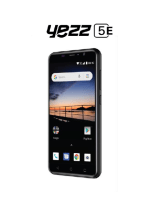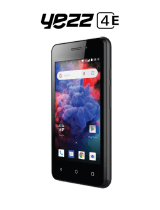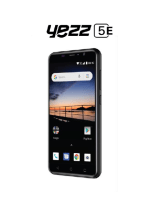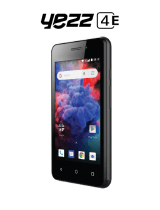Yezz 4E4 El manual del propietario
- Categoría
- Smartphones
- Tipo
- El manual del propietario

1
EN

2
SECURITY INFORMATION
Please remember to obey relevant rules and regulations whenever
use your phone. This will prevent bad effect from you and the
environment.
v.2016-09-15-ES
General security
When driving, riding your bike or walking,
do not use headphones or earphones. Your
attention could be diverted, which may
cause an accident and be against the law in
certain geographical areas. For safety
precautions do not use your phone while
driving, always stay aware of your
surroundings. Follow all safety instructions
and regulations relating to the use of your
device when you are driving a vehicle.
Don’t use at petrol stations.
Keep your phone at least 15 mm away from
your ear or body while making calls.

3
EN
Your phone may produce a bright or
flashing light.
Small parts may cause a choking.
Don’t dispose of your phone in fire.
To avoid any hearing damage, do not listen
to high volume levels for an extended.
Excessive sound pressure from earphones
and headphones can cause hearing loss.
Avoid contact with anything magnetic.
Keep away from pacemakers and other
electronic medical devices.
Avoid extreme temperatures.
Switch off when asked to in hospitals and
medical facilities.

4
Avoid contact with liquids. Keep your phone
dry.
Switch off when told to in aircrafts and
airports.
Don’t take your phone apart.
Switch off when near explosive materials or
liquids.
Only use approved accessories.
Don’t rely on your phone for emergency
communications.
Look at the adapter regularly, specifically at the plug
and the layer to detect any damages. If the adapter is
damaged, you can’t use it until it’s fixed.
Plug in the adapter to a power outlet which is easily
accessible. Always unplug the adapter after using it.
Use only the adapter provided with the device.

5
EN
Warning electrical hazard
To avoid serious injury, do not touch the
plug of the charger!
Disconnect the charger when you do not
use it.
To disconnect a charger or an accessory,
pull the plug, not the power cable.
The power module is the element that
allows you to disconnect the product.
The power plug must stay easily accessible.
Do not expose your device to direct sunlight, like on
your car’s dashboard, for example.
In case of overheating do not use the device.
Be careful when using the device while walking.
Do not subject the device to severe impact or drop it
from high position, it could cause damages or
malfunctions.
Do not disassemble, modify or fix the device by
yourself.
To clean the device use a clean and soft rag.
Do not use any chemical product or detergent.

6
INTRODUCING YOUR MOBILE PHONE
Learn about your mobile phone’s layout, keys, display and icons.
Phone layout
From the front view of your phone you will observe the following
elements:

7
EN
From the back view of your phone you will observe the following
elements:
Keys
The following table offers you a quick description about the
phone’s keys:
Key
Function
Power button
Allow you to turn on/off the device and to
lock the screen.
Volume
Allow you to adjust the volume of ringing
and notifications. Also allows you to adjust
the volume of multimedia content playback.

8
Back
Allow you to return to the previous menu or
screen. Also allow you to close some
applications.
Home
It takes you directly to the home screen,
leaving any application open.
Menu
Allow you to access to the functions menu
of the application or screen you are.

9
EN
Screen
The screen of your mobile phone is designed as follows:

10
Icons
Learn about the icons that are displayed on the top of the screen,
indicating the status of the phone:
Signal strength
Wi-Fi connection
Bluetooth On
EDGE connected
USB connected
HSPA connected
Battery meter
New message
Vibration profile
New email
Roaming indicator
Alarm active
Headset connected
Silent profile

11
EN
PREPARING YOUR MOBILE PHONE
Get started setting up your mobile phone for its first use.
Install the SIM card and battery
When you subscribe to a cellular service, you will receive a
Subscriber Identity Module (SIM) card, with subscription details,
such as your personal identification number (PIN) and optional
services.
To install the SIM card and battery,
1. Remove the battery cover.

12
2. Insert the SIM card.
Your phone has 2 SIM card slots to allow you use 2 SIM cards and
switch between them.
Place the SIM card in the phone with the gold-colored
contacts facing down.
Without inserting a SIM card, you can use your phone’s
non-network services and some menus.
3. Insert the battery.

13
EN
4. Replace the battery cover.
Insert a memory card (optional)
To store additional multimedia files, you must insert a memory
card.
Formatting the memory card on a PC may cause
incompatibility with your phone. Format the memory card
only on the phone.
1. Remove the battery cover.
2. Insert a memory holder with the label side facing up.

14
USING BASIC FUNCTIONS
Learn how to perform basic operations of your mobile phone.
Turn your phone on and off
To turn your phone on,
1. Long press the power button.
2. Type in your PIN number and press OK (if it is needed).
To shut down your phone, go to step 1 above.
Access menus and applications
To get access to the Menu and Applications,
1. At the home screen, touch the button on the screen to pop
up the list of Installed Applications in your phone.
2. Slide your finger to the right or left to access other pages of
apps.
3. Touch any icon to enter to the application.
4. To exit the application, press Back or Home at the bottom of the
screen.
Use basic call functions
Learn to make or answer calls in this section.

15
EN
Make a call:
1. At the home screen or applications menu, touch the Phone icon
.
2. Dial the area code and phone number.
3. Touch to start the call.
4. To end a call, touch .
To answer a call:
1. When you receive a call, slide the phone icon to the right to
answer it or slide it to the left to reject it .
2. To end the call, touch .
Send and view messages
In this section, learn how to send and receive:
- Text Messages (SMS).
- Multimedia Message (MMS).
Steps to send Text and Multimedia Messages:
1. Touch Messages at the application list, then touch on
the corner.
2. Type in the phone number or contact name on the field or touch

16
to access to Contacts.
3. Type in your message.
To send as text message go to step 5.
To attach a multimedia object (audio, image, etc.) continue to step
4.
4. Touch on the top right corner, select the attach type then
choose the item.
5. Touch to send the message.
Add contacts
Learn the basics of using the phonebook feature.
Add a new contact:
1. In the application list touch Contacts , then touch on
the bottom to add a new contact.
2. Fill the contact information (Name, Last name and phone
number). You can add more fields such as, email, address.
3. Touch on the top of the screen to save.
Search for a contact
1. In the application list touch Contacts.
2. Slide your finger from bottom to top to scroll the list or touch the

17
EN
search button and type in the first letters of the name or last
name.
3. To see the contact details touch the name or the picture of the
contact.
If you want to call a contact touch the phone number.
Listen to music
Learn how to listen to music via the music player or FM radio.
Listen to the FM radio:
1. Plug in the earphones in your phone.
2. In the application list touch FM Radio.
3. Use the tool bar at the bottom to change of station.
Listen to music files:
First, copy the music files into your phone internal memory or a
MicroSD card.
1. In the application list, touch Music.
2. Select an order at the top of the screen and touch the song that
you want to listen to.
3. You can Pause, Loop, or change of song using the tool bar at
the bottom.

18
Browse the web
Learn how to access to your favorites Web Sites.
1. In the application list, touch Browser.
2. Touch the address bar and type in the address of the web site
you want to go.

19
EN
USING THE CAMERA
Learn the basics to capture and view photos.
Capture pictures
1. In the applications list, touch Camera.
2. Adjusts the lens at the photo target and make the desired
adjustments by touching the settings button .
3. Touch the shot button on the screen to capture the picture.
It will be saved automatically.
See the captured pictures
In the applications list, touch Gallery and then select the
Camera folder to access and visualize all the pictures
captured by your phone.

20
CONNECTING TO INTERNET
Learn the basics to configure your phone and connect to Internet.
Add a new connection
1. In the applications list, touch Settings to access to the
device configuration.
2. Touch the option “More…”, then touch Mobile networks and
touch Access Point Names. Now select the SIM Card that you
want to configure.
3. Touch the Menu key and select New APN then, type in the
parameters according with your Carrier.
The basic parameters are:
Name
APN
Username
Password
Some carriers use Proxy Servers, refer to your carrier
configuration for more information.
4. When you finish typing in the parameters needed, touch Menu
then Save.
If you have multiples APN Configurations for the same SIM card,
choose which one you want to use touching the radio button at

21
EN
the right side of the name.
To add another connection, repeat from step 3.
Switch between carriers
(SIM cards)
If you use multiple SIM cards and want to switch to another one,
follow these steps:
1. In the applications list, touch Settings to access to the
device configuration.
2. Touch .
3. Choose the option Data connection and select the SIM Card
that you want to use.

22
USING THE Wi-Fi
Learn to use the phone's wireless capabilities to connect to any
wireless local area network compatible.
Connect to a wireless network
1. In the applications list, touch Settings to access to the
device configuration.
2. Touch the Wi-Fi option .
3. To turn the On the Wi-Fi touching the button on the right
top corner.
4. Choose a wireless network and enter the security password if it
is needed.
Disconnect from a wireless network
1. In the applications list, touch Settings to access to the
device configuration.
2. Touch the Wi-Fi option .
3. To turn the Wi-Fi off touch the button on the right top
corner.

23
EN
View the technical details of a wireless network
1. In the applications list, touch Settings to access to the
device configuration.
2. Touch the Wi-Fi option .
3. Touch the active wireless network to see details such as Link
Speed, Signal strength and more.

24
SAR
Please take time to read this important section.
RADIO WAVES
Proof of compliance whit international standards (ICNIRP) or with
European Directive 1999/5/EC (R&TTE) is required of all mobile
phone models before they can be put on the market. The
protection of the health and safety for the user any other person is
an essential requirement of these standards or this directive.
THIS DEVICE MEETS INTERNATIONAL GUIDELINES FOR
EXPOSURE TO RADIO WAVES
Your mobile device is a radio transmitter and receiver. It is
designed not to exceed the limits for exposure to radio waves
(radio frequency electromagnetic fields) recommended by
international guidelines. The guidelines were developed by an
independent scientific organization (ICNIRP) and include a
substantial safety margin designed to assure the safety of all
persons, regardless of age and health.
The radio wave exposure guidelines use a unit of measurement
known as the Specific Absorption Rate, or SAR. The SAR limit for
mobile devices is 2 W/kg.
Tests for SAR are conducted using standard operating positions
with the device transmitting at its highest certified power level in all
tested frequency bands.
Body-worn SAR testing has been carried out at a separation
distance of 1.0 cm. to meet RF exposure guidelines during body-

25
EN
worn operation, the device should be positioned at least this
distance away from the body. If you are not using an approved
accessory ensure that whatever product is used is free of any
metal and that it positions the phone the indicated distance away
from the body.
For more information you can go to www.sayyezz.com
Additional information about electromagnetic fields and public
health are available on the following site. http://www.who.int/peh-
emf.
Your telephone is equipped whit a built-in antenna. For optimal
operation, you should avoid touching it or degrading it.
As mobile devices offer a range of functions, they can be used in
positions other that against your ear. In such circumstances the
device will be compliant whit the guidelines when used with
headset or USB data cable. If you are using another accessory
ensure that whatever product is used is free of any metal and that
it positions the phone at least 1.0 cm away from the body.

26
FCC
Please take time to read this important section.
FCC Caution
Any Changes or modifications not expressly approved by the party
responsible for compliance could void the user's authority to
operate the equipment.
Before a new model phone is available for sale to the public, it
must be tested and certified to the FCC that it does not exceed the
exposure limit established by the FCC, Tests for each phone are
performed in positions and locations (e.g. at the ear and worn on
the body) as required by the FCC.
This device complies with part 15 of the FCC Rules. Operation is
subject to the following two conditions: (1) This device may not
cause harmful interference, and (2) this device must accept any
interference received, including interference that may cause
undesired operation.
Note: This equipment has been tested and found to comply with
the limits for a Class B digital device, pursuant to part 15 of the
FCC Rules. These limits are designed to provide reasonable
protection against harmful interference in a residential installation.
This equipment generates, uses and can radiate radio frequency
energy and, if not installed and used in accordance with the
instructions, may cause harmful interference to radio
communications. However, there is no guarantee that interference
will not occur in a particular installation. If this equipment does
cause harmful interference to radio or television reception, which
can be determined by turning the equipment off and on, the user is

27
EN
encouraged to try to correct the interference by one or more of the
following measures:
- Reorient or relocate the receiving antenna.
- Increase the separation between the equipment and receiver.
- Connect the equipment into an outlet on a circuit different from
that to which the receiver is connected.
- Consult the dealer or an experienced radio/TV technician for
help.

1
ES

2
INFORMACIÓN DE SEGURIDAD
Recuerde que debe obedecer las reglas y reglamentos
pertinentes cada vez que utilice su teléfono. Esto evitará efectos
negativos a usted y el medio ambiente.
v.2016-09-15-ES
Seguridad general
Cuando esté conduciendo, manejando su
bicicleta o caminando, no use sus
auriculares o audífonos. Su atención puede
ser distraída, lo que puede causar un
accidente y estar en contra de la ley en
algunas zonas geográficas. Por seguridad
no utilice el teléfono mientras está
conduciendo, siempre esté al tanto de su
entorno. Siga todas las instrucciones y
regulaciones de seguridad relacionadas
con el uso de su teléfono cuando esté
conduciendo un vehículo.
No use el teléfono en estaciones de
recarga de combustible.
Mantenga su teléfono al menos 15 mm
separado de su oreja o cuerpo cuando
realice llamadas.

3
ES
Su teléfono puede producir luces brillantes
o destellos.
Las partes pequeñas pueden causar
asfixia.
No deseche su teléfono en el fuego.
Para evitar cualquier daño auditivo, no
escuche con el volumen muy alto por
mucho tiempo. La presión acústica
excesiva de los auriculares y los audífonos
pueden causar pérdida de la audición.
Evite contacto con cualquier objeto
magnético.
Mantenga el teléfono lejos de marcapasos
y otros equipos médicos electrónicos.
Evite exponer el teléfono a temperaturas
extremas.

4
Apague el teléfono en hospitales e
instalaciones médicas cuando se le sea
solicitado.
Evite todo contacto con líquidos. Mantenga
su teléfono seco.
Apague el teléfono en aeropuertos y
aviones cuando se le sea solicitado.
No desarme su teléfono.
Apague su teléfono cuando esté cerca de
materiales o líquidos explosivos.
Use solo accesorios aprobados.
No confíe en su teléfono móvil para
comunicaciones de emergencia.

5
ES
Advertencia: Riesgo de electrocución.
Para evitar lesiones graves, no toque el
conector del cargador!
Desconecte el cargador cuando no lo
utilice.
Para desconectar el cargador o un
accesorio, hale el conector, no el cable.
El módulo de alimentación es el elemento
que permite desconectar el producto.
El conector a la corriente deberá
permanecer fácilmente accesible.
Mire el adaptador regularmente, específicamente al
enchufe y la capa para detectar cualquier daño. Si el
adaptador está dañado, no podrá usarlo hasta que
haya sido reparado.
Enchufe el adaptador a una toma de corriente la cual
es fácilmente accesible. Siempre desenchufe el
adaptador después de utilizarlo.
Use sólo el adaptador suministrado con el dispositivo.

6
No exponga su dispositivo directamente a la luz solar,
como el tablero de su vehículo, por ejemplo.
En caso de sobrecalentamiento, no utilice el
dispositivo.
Sea cuidadoso cuando use el dispositivo mientras
camina.
No someta el dispositivo a impactos severos o caídas
de gran altura, podría causar daños o un mal
funcionamiento.
No desarme, modifique o arregle el dispositivo por su
cuenta.
Para limpiar el dispositivo use un trapo limpio y suave.
No utilice ningún producto químico o detergente.

7
ES
PRESENTACIÓN DEL TELÉFONO MÓVIL
Aprenda sobre el diseño de su teléfono, teclas, pantalla e íconos.
Diseño del teléfono
Desde la vista frontal de su teléfono podrá observar los siguientes
elementos:

8
En la parte trasera del su teléfono podrá observar los siguientes
elementos:
Teclas
La siguiente tabla le ofrece una descripción breve de la función de
cada tecla del teléfono:
Tecla
Función
Encendido
Permite encender o apagar el teléfono.
Además, le permitirá bloquear la pantalla.
Volumen
Le permite ajustar el volumen de repique y
notificaciones. Además, le permite ajustar el
volumen del contenido multimedia en
reproducción.

9
ES
Atrás
Le permite volver al menú o pantalla
anterior. Además, le permitirá cerrar
algunas aplicaciones.
Inicio
Lo lleva directamente a la pantalla de
espera, saliendo de cualquier aplicación.
Menú
Le permite acceder al menú de funciones
de la aplicación o pantalla en la que se
encuentre.

10
Pantalla
La pantalla de su teléfono móvil está diseñada de la siguiente forma:

11
ES
Iconos
Conozca los íconos que se mostrarán en la parte superior de la
pantalla, indicando el estado del teléfono:
Fuerza de la señal
Conexión red Wi-Fi
Bluetooth encendido
EDGE conectado
USB conectado
HSPA conectado
Indicador de batería
Nuevo Mensaje
Modo vibración
Nuevo email
Indicador de
itinerancia
Alarma configurada
Auricular conectado
Perfil silencioso

12
PREPARANDO SU TELÉFONO MÓVIL
Comience la preparación de su teléfono móvil para utilizarlo por
primera vez.
Instalar la tarjeta SIM y la batería
Cuando usted contrata un servicio celular, usted recibirá un Módulo
de Identificación del Suscriptor o Tarjeta SIM, que contiene los
datos de su suscripción como su Número de Identificación Personal
(PIN) y servicios opcionales.
Para instalar la tarjeta SIM y la batería,
1. Remueva la cubierta trasera.

13
ES
2. Inserte la tarjeta SIM.
Su teléfono tiene dos espacios que le permiten utilizar dos tarjetas
SIM e intercambiar entre ellas.
Coloque la tarjeta SIM en el teléfono con los contactos
dorados hacia abajo.
Sin insertar una tarjeta SIM, usted puede utilizar las opciones
de su teléfono que no dependan de una operadora, así como
también algunos menús.
3. Inserte la batería.

14
4. Coloque la cubierta trasera.
Insertar una tarjeta de memoria (opcional)
Para almacenar archivos multimedia adicionales, usted debe
insertar una tarjeta de memoria.
Formatear la tarjeta de memoria en una computadora puede
causar incompatibilidad con su teléfono. Formatee la tarjeta
de memoria preferiblemente en el
1. Remueva la cubierta trasera.
2. Inserte la tarjeta de memoria con los contactos dorados hacia
abajo.

15
ES
USANDO LAS FUNCIONES BASICAS
Aprenda como realizar las operaciones básicas de su teléfono
móvil.
Encender y apagar su teléfono
Para encender su teléfono,
1. Presione y mantenga la tecla de encendido.
2. Introduzca su PIN y presione OK (si es necesario).
Para apagar su teléfono, repita el paso 1 señalado arriba.
Acceder al menú y aplicaciones
Para acceder al Menú y las aplicaciones de su teléfono,
1. En el modo de espera, toque el botón en la pantalla para
acceder a la lista de aplicaciones instaladas en su teléfono.
2. Deslice sus dedos hacia la derecha o izquierda para acceder a
otras páginas de aplicaciones.
3. Para abrir una aplicación, toque el icono en la lista.
4. Para salir de la aplicación presione la tecla Atrás o la tecla Inicio
en la parte inferior de la pantalla.
Uso de las funciones básicas de llamada
Aprenda como hacer o responder llamadas en esta sección.

16
Realizar una llamada:
1. En el modo de espera o dentro del menú, toque el icono
Teléfono.
2. Introduzca el código de área y el número telefónico a marcar.
3. Toque para marcar el número.
4. Para finalizar una llamada, presione .
Responder una llamada:
1. Cuando entre una llamada, deslice el icono del teléfono a la
derecha para aceptar la llamada o la izquierda para rechazarla
.
2. Para finalizar la llamada, presione .
Enviar y leer los mensajes
En esta sección, aprenda como enviar y leer:
- Mensajes de texto (SMS).
- Mensajes multimedia (MMS).
Para enviar un mensaje de texto o multimedia:
1. En la lista de aplicaciones, toque Mensajes y luego toque el
botón .
2. Ingrese el número o nombre del destinatario en el campo o toque

17
ES
el botón para acceder a la libreta de contactos.
3. Introduzca el texto de su mensaje.
Para enviar mensajes de texto, vaya al paso 5.
Para adjuntar un objeto multimedia (sonido, imagen, etc.) continúe
al paso 4.
4. Toque el botón en la esquina superior derecha, toque el tipo
de adjunto y luego seleccione el ítem.
5. Toque el botón para enviar el mensaje.
Agregar contactos
Aprenda los detalles básicos de cómo agregar y buscar un contacto.
Agregar un nuevo contacto:
1. En la lista de aplicaciones toque Contactos y luego toque el
botón en la esquina inferior derecha para agregar un contacto.
2. Introduzca la información de contacto como Nombre, Apellido y
número de teléfono. Puede agregar datos adicionales como email,
dirección, etc.
3. Toque el botón en la parte superior para guardar el contacto.
Buscan un contacto

18
1. En la lista de aplicaciones toque Contactos.
2. Deslice su dedo desde abajo hacia arriba para desplazarse por
la lista o toque el botón de búsqueda e introduzca las primeras
letras del nombre o apellido.
3. Para ver los detalles del contacto toque sobre el nombre o sobre
la foto.
Si desea llamar al contacto, toque sobre el número de teléfono.
Escuchar música
Aprenda como escuchar música utilizando el reproductor
multimedia o la Radio FM.
Escuchar Radio FM:
1. Conecte los auriculares en el conector del teléfono.
2. En la lista de aplicaciones toque Transmisión FM.
3. Utilice las teclas de la barra inferior para cambiar las estaciones.
Escuchar archivos de música:
Luego de transferir los archivos de música a la memoria de su
teléfono o tarjeta de memoria,
1. En la lista de aplicaciones toque Música.
2. Seleccione un orden en la parte superior y toque la canción que
desee para comenzar su reproducción.
3. Puede detener, repetir o cambiar de canción utilizando los

19
ES
botones de la barra inferior.
Navegar en Internet
Aprenda como acceder a sus páginas web favoritas.
1. En la lista de aplicaciones seleccione Navegador.
2. Toque el campo de dirección e introduzca la dirección de la
página web que desee visitar.

20
USO DE LA CÁMARA
Aprenda como usar la cámara para tomar fotos y ver las mismas.
Tomar fotos
1. En la lista de aplicaciones, seleccione Cámara.
2. Apunte el lente al objetivo de la foto y haga los ajustes que desee
tocando el botón de ajustes .
3. Toque el botón de disparo en la pantalla para capturar la
imagen. La foto se guardará de forma automática.
Ver las fotos tomadas
En la lista de aplicaciones toque Galería y luego seleccione la
carpeta Cámara para acceder y visualizar las fotos tomadas
con su teléfono.

21
ES
CONECTANDO A INTERNET
Aprenda sobre el diseño de su teléfono, teclas, pantalla e íconos.
Agregar una nueva conexión
1. En la lista de aplicaciones toque Ajustes para acceder a la
configuración del equipo.
2. Toque en la opción Más…, luego Redes móviles y finalmente
APN, ahora seleccione la tarjeta SIM a la que desea configurarle
la cuenta de datos.
3. Toque la tecla Menú y seleccione Nuevo APN e introduzca los
parámetros de acuerdo a su operadora.
Los parámetros básicos son:
Nombre
APN
Nombre de usuario
Contraseña
Algunas operadoras utilizan servidores Proxy. Refiérase a la
configuración de su operadora para más información.
4. Una vez ingresados los parámetros necesarios, toque la tecla
Menú y seleccione Guardar.
Si posee múltiples configuraciones para este SIM, puede activar la
que desee utilizar tocando la marca de selección a la derecha

22
del nombre.
Para agregar otra conexión, repita los pasos desde el número 3.
Cambiar entre operadoras
(Tarjetas SIM)
Si usted utiliza múltiples tarjetas SIM y desea cambiar a otra, siga
estos pasos:
1. En la lista de aplicaciones toque Ajustes para acceder a la
configuración del equipo.
2. Toque la opción .
3. Ingrese en la opción Conexión de datos y seleccione la tarjeta
SIM que desea utilizar para conectar a Internet.

23
ES
USO DE LA RED INALÁMBRICA
Aprenda a utilizar las capacidades inalámbricas del teléfono para
conectarse a cualquier red de área local inalámbrica compatible.
Conectar a una red inalámbrica
1. En la lista de aplicaciones toque Ajustes para acceder a la
configuración del equipo.
2. Toque la opción Wi-Fi .
3. Para encender el Wi-Fi toque el botón de encendido en la
esquina superior derecha.
4. Seleccione la red inalámbrica de su preferencia e introduzca la
contraseña de seguridad si ésta lo requiere.
Desconectar de una red inalámbrica
1. En la lista de aplicaciones toque Ajustes para acceder a la
configuración del equipo.
2. Toque la opción Wi-Fi .
3. Para desactivar el Wi-Fi toque el botón de encendido en
la esquina superior derecha.

24
Visualizar los detalles técnicos de una red inalámbrica
1. En la lista de aplicaciones toque Ajustes para acceder a la
configuración del equipo.
2. Toque la opción Wi-Fi .
3. Toque la red inalámbrica a la que está conectado para
visualizar información como velocidad, nivel de señal y más.

25
ES
SAR
Por favor tome tiempo para leer este importante mensaje.
ONDAS DE RADIO
La declaración de conformidad con los estándares internacionales
(ICNIRP) o la Directiva Europea 1999/5/EC (R&TTE) es requerida
por todos los modelos de teléfonos móviles antes de que puedan
ser puestos en el mercado. La protección de la salud y seguridad
del usuario y de cualquier otra persona es un requisito esencial de
estas normas o directivas.
ESTE DISPOSITIVO CUMPLE CON LAS DIRECTRICES
INTERNACIONALES SOBRE LA EXPOSICIÓN A ONDAS DE
RADIO.
Su dispositivo móvil es un radiotransmisor y radiorreceptor. Está
diseñado para no exceder los límites de exposición a ondas de
radio (campos electromagnéticos de radiofrecuencia)
recomendados por las normas internacionales. Las normas fueron
desarrolladas por una organización científica independiente
(ICNIRP) e incluyen un margen de seguridad considerable
diseñado para garantizar la seguridad de todas las personas,
independientemente de su edad y condición de salud.
Las normas de exposición a ondas de radio utilizan una unidad de
medida denominada la Tasa de Absorción Específica o TAE. El
límite de la TAE para los dispositivos móviles es 2 Wkg.
Las pruebas de la TAE son realizadas utilizando posiciones de
operación estándar con el dispositivo transmitiendo a su nivel de
potencia certificado más alto en todas las bandas de frecuencia

26
probadas.
Las pruebas de TAE en el cuerpo se han realizado a una distancia
de separación de 1,0 cm. para cumplir con las pautas de exposición
RF. Durante la operación cerca del cuerpo, el dispositivo debe ser
colocado por lo menos a esta distancia del cuerpo. Si usted no está
utilizando un accesorio aprobado asegúrese de que cualquiera que
sea el producto que está utilizando, esté libre de cualquier metal y
que el teléfono sea puesto a la distancia indicada del cuerpo.
Para más información puedes ir a www.sayyezz.com.
La información adicional sobre campos electromagnéticos y salud
pública está disponible en el siguiente sitio web.
http://www.who.int/peh-emf.
Su teléfono está equipado con una antena incorporada. Para un
funcionamiento óptimo, evite tocarla o dañarla.
Ya que los dispositivos móviles ofrecen una amplia gama de
funciones, pueden ser utilizados en otras posiciones que no sean
junto a su oreja. En tales circunstancias el dispositivo estará acorde
con las pautas cuando es usado con un cable de datos USB o un
auricular. Si usted está usando otro accesorio asegúrese de que
cualquier producto que esté utilizando esté libre de cualquier metal
y de colocar el teléfono por lo menos a 1.0 cm de distancia de su
cuerpo.
Además, también se recomienda el uso tanto como sea posible de
los auriculares. Sin embargo, hay que tomar precauciones en este
caso para mantener los teléfonos móviles alejados de la barriga de
las mujeres embarazadas y de la parte baja del abdomen de niños
y adolescentes.
La información científica actual no indica que el uso de teléfonos
móviles requiera tomar alguna precaución. Sin embargo, mientras
algunos están preocupados por los riesgos potenciales asociados
con un período de uso excesivo del teléfono, nosotros les

27
ES
recomendamos usar los auriculares para mantener el teléfono
móvil lejos de la cabeza y el cuerpo.
Prevención de la pérdida de audición
Hay riesgos irreversibles de pérdida de audición si el receptor, los
auriculares, el altavoz o los audífonos son usados en un volumen
alto. Regule el volumen a un nivel que no represente peligro. Con
el tiempo, puede acostumbrarse a un volumen más alto que
parecerá normal, pero es perjudicial para su audición. Si usted está
experimentando zumbidos o sonidos distorsionados, le sugerimos
que consulte a un especialista de la audición. Mientras más alto sea
el volumen, mayor es el riesgo de que su audición pueda dañarse
rápidamente. Los especialistas en audición sugieren las siguientes
recomendaciones:
Limite la duración del uso del volumen alto en los auriculares, el
altavoz o el auricular.
Evite subir el volumen para cubrir un ambiente ruidoso.
Baje el volumen si no puede escuchar a la gente hablando cerca
de usted.

28
FCC
Por favor tome tiempo para leer este importante mensaje.
Advertencia de FCC
Este dispositivo cumple con la Parte 15 de las Normas de la FCC.
La operación está sujeta a la condición de que este dispositivo no
puede causar interferencias perjudiciales.
Antes de que un nuevo modelo de teléfono esté disponible para la
venta al público, debe ser probado y certificado ante la FCC que
este no supere el límite de exposición establecido por la FCC, las
pruebas para cada teléfono se realizan en posiciones y ubicaciones
(por ejemplo en la oreja y llevándolo en el cuerpo) según los
requisitos de la FCC.
Precaución: Los cambios o modificaciones no aprobados
expresamente por la parte responsable del cumplimiento podrían
anular la autoridad del usuario para operar el equipo.
NOTA: Este equipo ha sido probado y cumple con los límites para
un dispositivo digital de Clase B, de conformidad con la Parte 15
del Reglamento de la FCC. Estos límites están diseñados para
proporcionar una protección razonable contra interferencias
perjudiciales en una instalación residencial.
Este equipo genera, utiliza y puede irradiar energía de
radiofrecuencia y, si no se instala y utiliza de acuerdo con las
instrucciones, puede causar interferencias en las comunicaciones
de radio. Sin embargo, no hay garantía de que no se produzcan
interferencias en una instalación particular. Si este equipo causa
interferencias perjudiciales en la recepción de radio o televisión, lo

29
ES
cual puede ser determinada apagando y encendiendo el equipo, se
recomienda al usuario que intente corregir la interferencia mediante
una o más de las siguientes medidas:
- Reoriente o reubique la antena receptora.
- Aumentar la separación entre el equipo y el receptor.
- Conectar el equipo a un tomacorriente diferente de aquel al que
está conectado el receptor.
- Consulte al distribuidor o un técnico experimentado en radio / TV
para obtener ayuda
-
 1
1
-
 2
2
-
 3
3
-
 4
4
-
 5
5
-
 6
6
-
 7
7
-
 8
8
-
 9
9
-
 10
10
-
 11
11
-
 12
12
-
 13
13
-
 14
14
-
 15
15
-
 16
16
-
 17
17
-
 18
18
-
 19
19
-
 20
20
-
 21
21
-
 22
22
-
 23
23
-
 24
24
-
 25
25
-
 26
26
-
 27
27
-
 28
28
-
 29
29
-
 30
30
-
 31
31
-
 32
32
-
 33
33
-
 34
34
-
 35
35
-
 36
36
-
 37
37
-
 38
38
-
 39
39
-
 40
40
-
 41
41
-
 42
42
-
 43
43
-
 44
44
-
 45
45
-
 46
46
-
 47
47
-
 48
48
-
 49
49
-
 50
50
-
 51
51
-
 52
52
-
 53
53
-
 54
54
-
 55
55
-
 56
56
Yezz 4E4 El manual del propietario
- Categoría
- Smartphones
- Tipo
- El manual del propietario
en otros idiomas
- English: Yezz 4E4 Owner's manual
Artículos relacionados
Otros documentos
-
Yezz Mobile Epic T Manual de usuario
-
Yezz Mobile Epic T Manual de usuario
-
Energizer ENERGY 400 El manual del propietario
-
 Yezz Mobile 5E5 Guía del usuario
Yezz Mobile 5E5 Guía del usuario
-
 Yezz Mobile 4E7 Instrucciones de operación
Yezz Mobile 4E7 Instrucciones de operación
-
 Yezz Mobile 5E5 Guía del usuario
Yezz Mobile 5E5 Guía del usuario
-
 Yezz Mobile 4E7 El manual del propietario
Yezz Mobile 4E7 El manual del propietario
-
 Yezz Mobile 5E4 Guía del usuario
Yezz Mobile 5E4 Guía del usuario
-
 Yezz Mobile 5E4 Guía del usuario
Yezz Mobile 5E4 Guía del usuario





























































